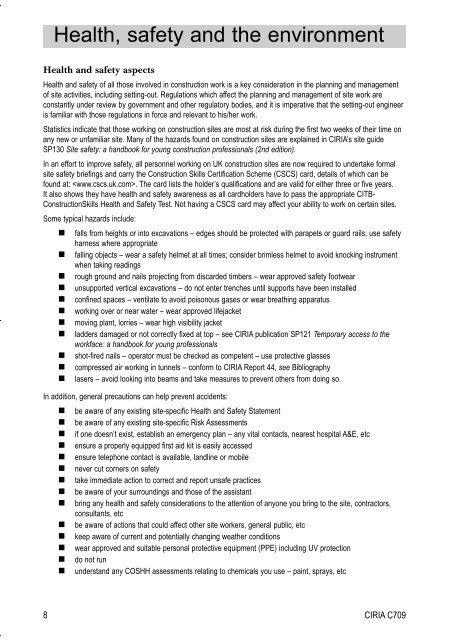Download - Engineering Surveyor
Download - Engineering Surveyor
Download - Engineering Surveyor
- No tags were found...
Create successful ePaper yourself
Turn your PDF publications into a flip-book with our unique Google optimized e-Paper software.
Health, safety and the environmentHealth and safety aspectsHealth and safety of all those involved in construction work is a key consideration in the planning and managementof site activities, including setting-out. Regulations which affect the planning and management of site work areconstantly under review by government and other regulatory bodies, and it is imperative that the setting-out engineeris familiar with those regulations in force and relevant to his/her work.Statistics indicate that those working on construction sites are most at risk during the first two weeks of their time onany new or unfamiliar site. Many of the hazards found on construction sites are explained in CIRIA’s site guideSP130 Site safety: a handbook for young construction professionals (2nd edition).In an effort to improve safety, all personnel working on UK construction sites are now required to undertake formalsite safety briefings and carry the Construction Skills Certification Scheme (CSCS) card, details of which can befound at: . The card lists the holder’s qualifications and are valid for either three or five years.It also shows they have health and safety awareness as all cardholders have to pass the appropriate CITB-ConstructionSkills Health and Safety Test. Not having a CSCS card may affect your ability to work on certain sites.Some typical hazards include: falls from heights or into excavations – edges should be protected with parapets or guard rails; use safetyharness where appropriate falling objects – wear a safety helmet at all times; consider brimless helmet to avoid knocking instrumentwhen taking readings rough ground and nails projecting from discarded timbers – wear approved safety footwear unsupported vertical excavations – do not enter trenches until supports have been installed confined spaces – ventilate to avoid poisonous gases or wear breathing apparatus working over or near water – wear approved lifejacket moving plant, lorries – wear high visibility jacket ladders damaged or not correctly fixed at top – see CIRIA publication SP121 Temporary access to theworkface: a handbook for young professionals shot-fired nails – operator must be checked as competent – use protective glasses compressed air working in tunnels – conform to CIRIA Report 44, see Bibliography lasers – avoid looking into beams and take measures to prevent others from doing so.In addition, general precautions can help prevent accidents: be aware of any existing site-specific Health and Safety Statement be aware of any existing site-specific Risk Assessments if one doesn’t exist, establish an emergency plan – any vital contacts, nearest hospital A&E, etc ensure a properly equipped first aid kit is easily accessed ensure telephone contact is available, landline or mobile never cut corners on safety take immediate action to correct and report unsafe practices be aware of your surroundings and those of the assistant bring any health and safety considerations to the attention of anyone you bring to the site, contractors,consultants, etc be aware of actions that could affect other site workers, general public, etc keep aware of current and potentially changing weather conditions wear approved and suitable personal protective equipment (PPE) including UV protection do not run understand any COSHH assessments relating to chemicals you use – paint, sprays, etc8 CIRIA C709
















